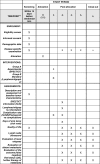Sentinel lymph node excision with or without preoperative hybrid single-photon emission computed tomography/computed tomography (SPECT/CT) in melanoma: study protocol for a multicentric randomized controlled trial
- PMID: 30717811
- PMCID: PMC6360709
- DOI: 10.1186/s13063-019-3197-7
Sentinel lymph node excision with or without preoperative hybrid single-photon emission computed tomography/computed tomography (SPECT/CT) in melanoma: study protocol for a multicentric randomized controlled trial
Abstract
Background: Melanoma has become a growing interdisciplinary problem in public health worldwide. According to the World Health Organization, the incidence of melanoma is increasing faster than any other cancer in the world. Because melanoma metastasizes early into the regional lymph nodes, sentinel lymph node excision (SLNE) is included in the current American Joint Committee of Cancer guidelines. However SLNE of melanoma has a high false-negative rate of up to 44%.
Methods: The gold standard for detection and extirpation of the sentinel lymph node is preoperative lymphoscintigraphy. SPECT/CT provides complementary information: the advantages include accurate anatomical localization, identification of false positives, reduction in the number of false negatives, and alteration of the surgical approach. Therefore, sentinel lymph node-SPECT/CT provides valuable information before sentinel lymph node excision and advocates its use in melanoma. We present a multicenter, unblinded superiority randomized controlled trial to compare SPECT/CT-aided SLNE versus standard SLNE in melanoma patients.
Discussion: The primary efficacy endpoint is distant metastasis-free survival. Secondary endpoints comprise overall survival, disease-free survival, rate of local relapses within the follow-up period (false-negative rate of sentinel lymph node), number of positive sentinel lymph nodes (sensitivity, false-positive rate), complication rate, quality of life, quality-adjusted life years, inpatient days, and overall costs during hospital stays.
Trial registration: ClinicalTrials.gov, NCT03683550 . Registered on 20 September 2018.
Keywords: Malignant melanoma; SPECT/CT; Sentinel lymph node excision.
Conflict of interest statement
Ethics approval and consent to participate
This clinical trial will be undertaken strictly according to the protocol and GCP regulations. The study protocol was approved by the Institutional Review Board (IRB) of the University Hospital Essen (18–8288-BO). All participants will receive oral and written information about the trial and must give their written informed consent before enrolment. Participants are free to withdraw at any time.
Consent for publication
Not applicable.
Competing interests
The authors declare that they have no competing interests.
Publisher’s Note
Springer Nature remains neutral with regard to jurisdictional claims in published maps and institutional affiliations.
Figures




References
-
- Cancer Facts & Figures 2011. http://www.cancer.org/Research/CancerFactsFigures/index.
-
- Melanoma Skin Cancer Overview. http://www.cancer.org/Cancer/SkinCancer-Melanoma/index.
-
- Livingstone E, Windemuth-Kieselbach C, Eigentler TK, Rompel R, Trefzer U, Nashan D, et al. A first prospective population-based analysis investigating the actual practice of melanoma diagnosis, treatment and follow-up. Eur J Cancer. 2011;47(13):1977–1989. - PubMed
-
- Balch CM. Surgical management of regional lymph nodes in cutaneous melanoma. J Am Acad Dermatol. 1980;3(5):511–524. - PubMed
-
- Gershenwald JE, Ross MI. Sentinel-lymph-node biopsy for cutaneous melanoma. N Engl J Med. 2011;364(18):1738–1745. - PubMed
Publication types
MeSH terms
Associated data
Grants and funding
LinkOut - more resources
Full Text Sources
Medical

